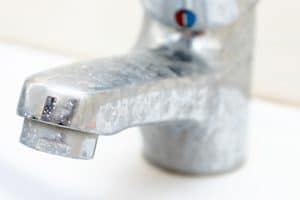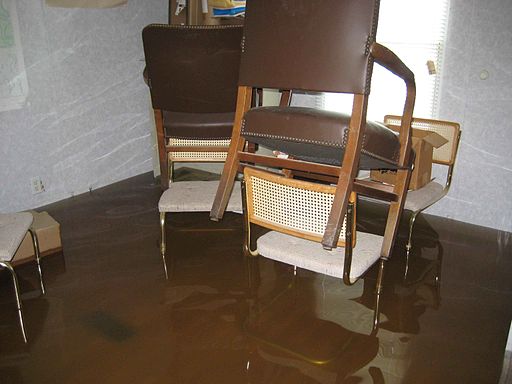Damage Caused by Hard Tap Water
Water is an excellent solventA solvent is a liquid capable of dissolving other substances... More, meaning it is easily able to dissolve other substances. “Hard” water holds a high amount of dissolved minerals in its solutionA solution is a homogeneous mixture of two or more substance... More because it easily dissolves such impurities. It is not considered a health risk, but it is inconvenient because it causes soap to perform poorly and mineral buildup on household fixtures.
Water becomes “hard” by moving through soil and rock and holding small, dissolved amounts of minerals in its solutionA solution is a homogeneous mixture of two or more substance... More. Calcium and magnesium are the two most common minerals dissolved into “hard” water. Water’s “hardness” increases as the calcium and magnesium content within it increases. This is because the degree of hardness in water is correlated with the multivalent cations dissolved.
Indications

Hard water causes a film on shower walls, shower doors, sinks, faucets, bathtubs, and other appliances.
Water is involved in so many household chores and appliances that it is incredibly inconvenient when hard water makes things needlessly more difficult. Hard water affects your dishwashing, laundry, bathing, and many other everyday activities. Make sure you look for the following indications of hard water in your home.
When hard water encounters soap, the dissolved minerals combine with the soap and form soap curds. Soap curds are less effective during dishwashing, so an excessive amount of soap is used to achieve satisfactory cleaning. Similarly, certain synthetic detergents don’t have their desired effect when combined with hard water because the hardness inactivates the detergent’s primary ingredient. Using too much soap or detergent causes dishes to have spotting or a soapy film when dry.
Hard water also encounters soap in laundering, and the soap curds lodge themselves into fabric during washing. This interferes with the washing process and prevents the dirt in the clothes from being completely removed. As a result, the fabric becomes rough and stiff and may begin to develop a foul odorAn odor is a smell, often detectable by the human nose, whic... More. Hard water affects the clothes by lessening the bright colors and making them appear dingy. These clothes often have a short shelf life since they quickly become scratchy and rough.
Bathing with hard water and soap curds is unpleasant because it affects your personal hygiene rather than a household chore. Hard water causes hair to look dull and feel sticky, and soap curds make hair lifeless and flat. Similarly, soap curds leave a soapy film on the skin when bathing and prevents the skin from returning to its natural condition. The soap curd film often prevents the removal of bacteria, soil, and dirt from the skin and can cause irritation. Bathing in hard water is unhygienic because it causes damage to your skin and hair by failing to remove all the dirt and bacteria.
Hard water causes a film on shower walls, shower doors, sinks, faucets, bathtubs, and other appliances. Soap curds cause a soapy film on dishes, showers, bathtubs, and other water fixtures. This causes certain rooms in the house, such as bathrooms and kitchens, to be much harder to clean and maintain.
Water fixtures and appliances often become inefficient when encountered with hard water, which is frustrating and often costly for the homeowner. Hard water that becomes heated forms a solid deposit of calcium and magnesium minerals. This deposit can cause pipes to clog and eventually need replacement. Clogged pipes reduce water flow and lowers the efficiency of water-based appliances. There are often problems with stains in these fixtures as well.
Health Effects
Drinking hard water is not a health risk, so there is no reason to panic if you have been ingesting it. The National Research Council (National Academy of Sciences) concluded that hard water contributes a small amount to the calcium and magnesium that the human body needs. In some cases, hard water can contribute to much more than a small amount if the level of dissolved calcium and magnesium is very high.
There has been much research on the possible link between hard water and cardiovascular disease mortality. These studies are “epidemiological,” which analyzes the statistical relationship between the two subjects. Some studies suggest a correlation between water hardness and lower cardiovascular disease mortality, while others do not suggest any correlation at all.
The National Research Council says that the current results are inconclusive and recommends that further research be conducted on the topic. The World Health Organization (WHO) aims to coordinate a worldwide study on the changes in cardiovascular disease after it encounters hard water, which may finally reach a definitive conclusion.
Testing
There are a variety of different ways to test your water for hardness levels. Both public and private water systems have options for water testing.
Water Testing
If you have a public water supply, ask your public water system operator to tell you about the hardness level in your water. Or, if you are more hands on, ask your operator for the consumer confidence report (CCR) they fill out annually. The report includes information about the hardness of your water, and you can look over the results yourself.
If you have a private water supply, hire a water testing laboratory to test your hardness levels. The laboratory charges a fee, but the results are also much more accurate than a DIY water testing kit.
DIY water tests can estimate water hardness well and are available at water treatment/supply companies. However, be sure you understand how the test works, the condition of your measured water, and how to interpret the results.
Interpreting Water Test Results
The Environmental Protection Agency (ETA) has two categories to ensure drinking water is of good quality: primary and secondary. Primary standards consider only health effects and secondary standards are based on the properties of the water, such as color, odorAn odor is a smell, often detectable by the human nose, whic... More, taste, foaming, and staining.
However, there is no primary or secondary standard for water hardness, so it must be measured a different way. Hardness levels are typically reported in grains per gallon (gpg) and milligrams per liter (mg/l) or parts per million (ppm).
The U.S. Department of Inferior and the Water Quality Association defines water hardness as:
| Hardness level | gpg | mg/l OR ppm |
| Soft | 0-1 | 0-17.1 |
| Slightly hard | 1-3.5 | 17.1-60 |
| Moderately hard | 3.5-7.0 | 60-120 |
| Hard | 7.0-10.5 | 120-180 |
| Very hard | 10.5+ | 180+ |
Options
The available options for controlling water hardness. You can purchase products that work to eliminate water hardness. These include a mechanical water softening unit or a packaged water softener, which is either precipitating or non-precipitating.
Mechanical water softening units are permanently installed in your plumbing to remove calcium and magnesium from the water. Water passes through a media bed and the water beads contain sodium. As the ion passes through, the hard minerals attach themselves to the beads and the sodium releases into the water. This way, sodium is replacing calcium and magnesium and the leftover minerals are discharged.
Precipitating water softeners use borax and washing soda to create an insoluble precipitate with calcium and magnesium. The minerals are unable to interfere with efficiency in cleaning or washing, but the precipitate creates cloudy build-up on surfaces and can damage skin when used for bathing.
Non-precipitating water softeners use phosphates to isolate calcium and magnesium. There are none of the unfortunate side effects listed above and, if used enough, non-precipitating water softeners can dissolve soap curds for a certain amount of time.
Sometimes hard water can cause damage or clogs in plumbing fixtures and appliances that leadLead is a heavy metal that can be toxic to humans, especiall... More to leaks. If your appliances or plumbing fixtures leak into your home and cause damage, make sure you contact a water damage restoration professional. These professionals will remove the excess water and restore any resulting damage.












